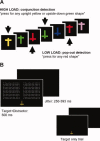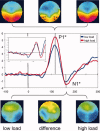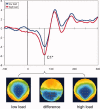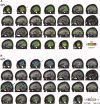Effects of attentional load on early visual processing depend on stimulus timing
- PMID: 21438076
- PMCID: PMC6870163
- DOI: 10.1002/hbm.21193
Effects of attentional load on early visual processing depend on stimulus timing
Abstract
A growing number of studies suggest that early visual processing is not only affected by low-level perceptual attributes but also by higher order cognitive factors such as attention or emotion. Using high-density electroencephalography, we recently demonstrated that attentional load of a task at fixation reduces the response of primary visual cortex to irrelevant peripheral stimuli, as indexed by the C1 component. In the latter study, peripheral stimuli were always presented during intervals without task-relevant stimuli. Here, we use a similar paradigm but present central task stimuli and irrelevant peripheral stimuli simultaneously while keeping all other stimulus characteristics constant. Results show that rather than to suppress responses to peripheral stimulation, high attentional load elicits higher C1 amplitudes under these conditions. These findings suggest that stimulus timing can profoundly alter the effects of attentional load on the earliest stages of processing in human visual cortex.
Copyright © 2011 Wiley Periodicals, Inc.
Figures




Similar articles
-
Attentional load and sensory competition in human vision: modulation of fMRI responses by load at fixation during task-irrelevant stimulation in the peripheral visual field.Cereb Cortex. 2005 Jun;15(6):770-86. doi: 10.1093/cercor/bhh178. Epub 2004 Sep 30. Cereb Cortex. 2005. PMID: 15459076
-
Earliest stages of visual cortical processing are not modified by attentional load.Hum Brain Mapp. 2014 Jul;35(7):3008-24. doi: 10.1002/hbm.22381. Epub 2013 Nov 4. Hum Brain Mapp. 2014. PMID: 25050422 Free PMC article.
-
Attentional load modifies early activity in human primary visual cortex.Hum Brain Mapp. 2009 May;30(5):1723-33. doi: 10.1002/hbm.20636. Hum Brain Mapp. 2009. PMID: 18711710 Free PMC article.
-
Processing local signals into global patterns.Curr Opin Neurobiol. 2007 Apr;17(2):132-9. doi: 10.1016/j.conb.2007.03.003. Epub 2007 Mar 21. Curr Opin Neurobiol. 2007. PMID: 17369036 Review.
-
The experimental parameters that affect attentional modulation of the ERP C1 component.Cogn Neurosci. 2018 Jan-Apr;9(1-2):53-62. doi: 10.1080/17588928.2017.1369021. Epub 2017 Sep 8. Cogn Neurosci. 2018. PMID: 28826303 Review.
Cited by
-
Your emotion or mine: labeling feelings alters emotional face perception-an ERP study on automatic and intentional affect labeling.Front Hum Neurosci. 2013 Jul 23;7:378. doi: 10.3389/fnhum.2013.00378. eCollection 2013. Front Hum Neurosci. 2013. PMID: 23888134 Free PMC article.
-
Effects of Multimodal Load on Spatial Monitoring as Revealed by ERPs.PLoS One. 2015 Sep 3;10(9):e0136719. doi: 10.1371/journal.pone.0136719. eCollection 2015. PLoS One. 2015. PMID: 26335779 Free PMC article.
-
Predictions penetrate perception: Converging insights from brain, behaviour and disorder.Conscious Cogn. 2017 Jan;47:63-74. doi: 10.1016/j.concog.2016.05.003. Epub 2016 May 21. Conscious Cogn. 2017. PMID: 27222169 Free PMC article. Review.
-
No Evidence that Predictions and Attention Modulate the First Feedforward Sweep of Cortical Information Processing.Cereb Cortex. 2019 May 1;29(5):2261-2278. doi: 10.1093/cercor/bhz038. Cereb Cortex. 2019. PMID: 30877784 Free PMC article.
-
Modulation of the Earliest Component of the Human VEP by Spatial Attention: An Investigation of Task Demands.Cereb Cortex Commun. 2020 Aug 5;1(1):tgaa045. doi: 10.1093/texcom/tgaa045. eCollection 2020. Cereb Cortex Commun. 2020. PMID: 34296113 Free PMC article.
References
-
- Amunts K, Malikovic A, Mohlberg H, Schormann T, Zilles K ( 2000): Brodmann's areas 17 and 18 brought into stereotaxic space—Where and how variable? Neuroimage 11: 66–84. - PubMed
-
- Bahcall DO, Kowler E ( 1999): Attentional interference at small spatial separations. Vis Res 39: 71–86. - PubMed
-
- Blake R, Lee S‐H ( 2005): The role of temporal structure in human vision. Behav Cogn Neurosci Rev 4: 21–42. - PubMed
-
- Brefczynski JA, DeYoe EA ( 1999): A physiological correlate of the ‘spotlight’ of visual attention. Nat Neurosci 2: 370–374. - PubMed
Publication types
MeSH terms
LinkOut - more resources
Full Text Sources

